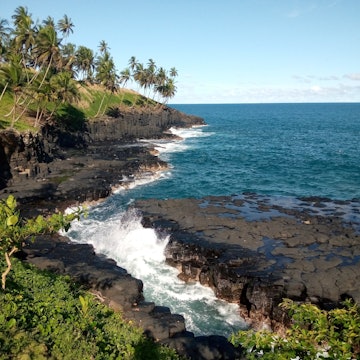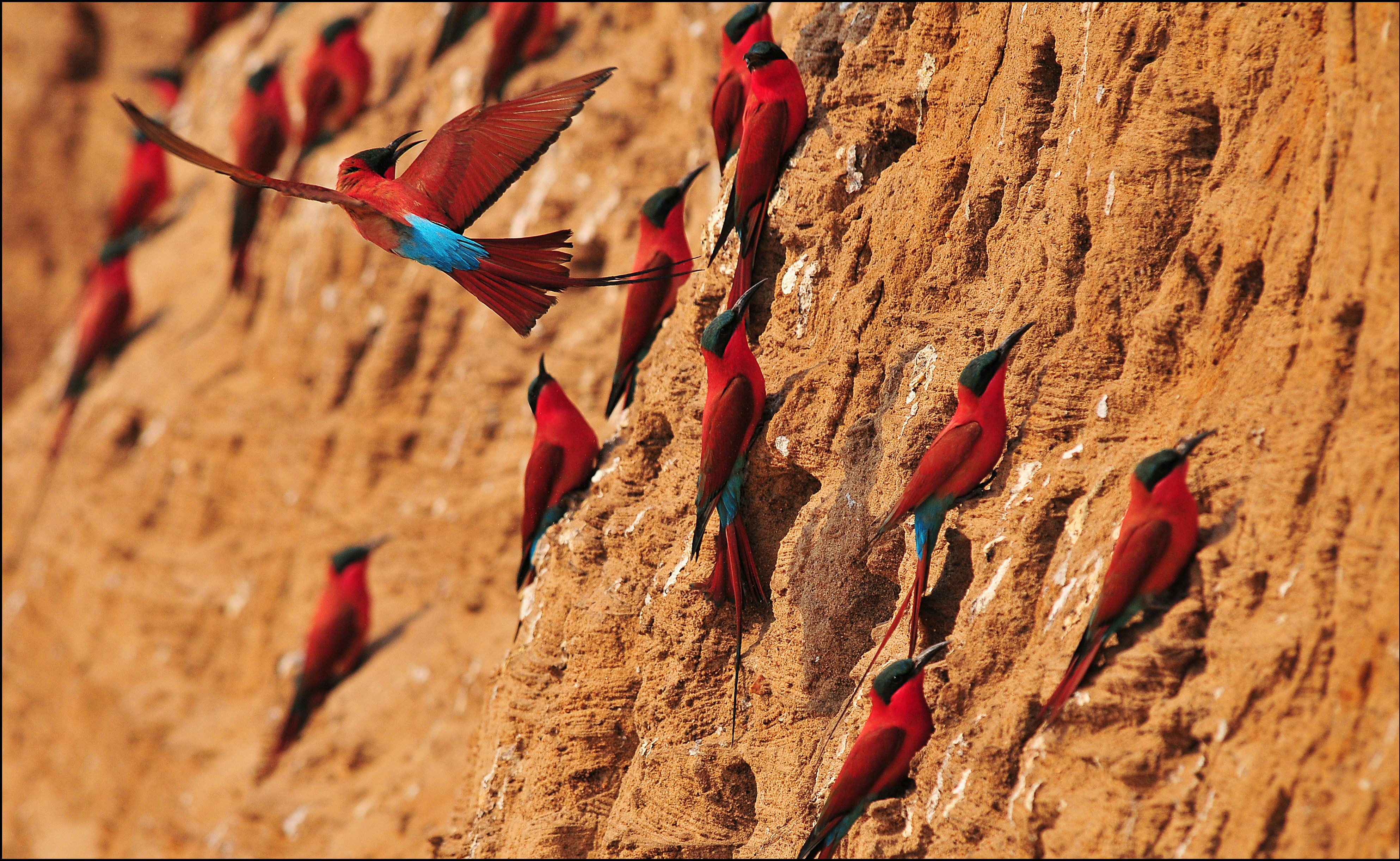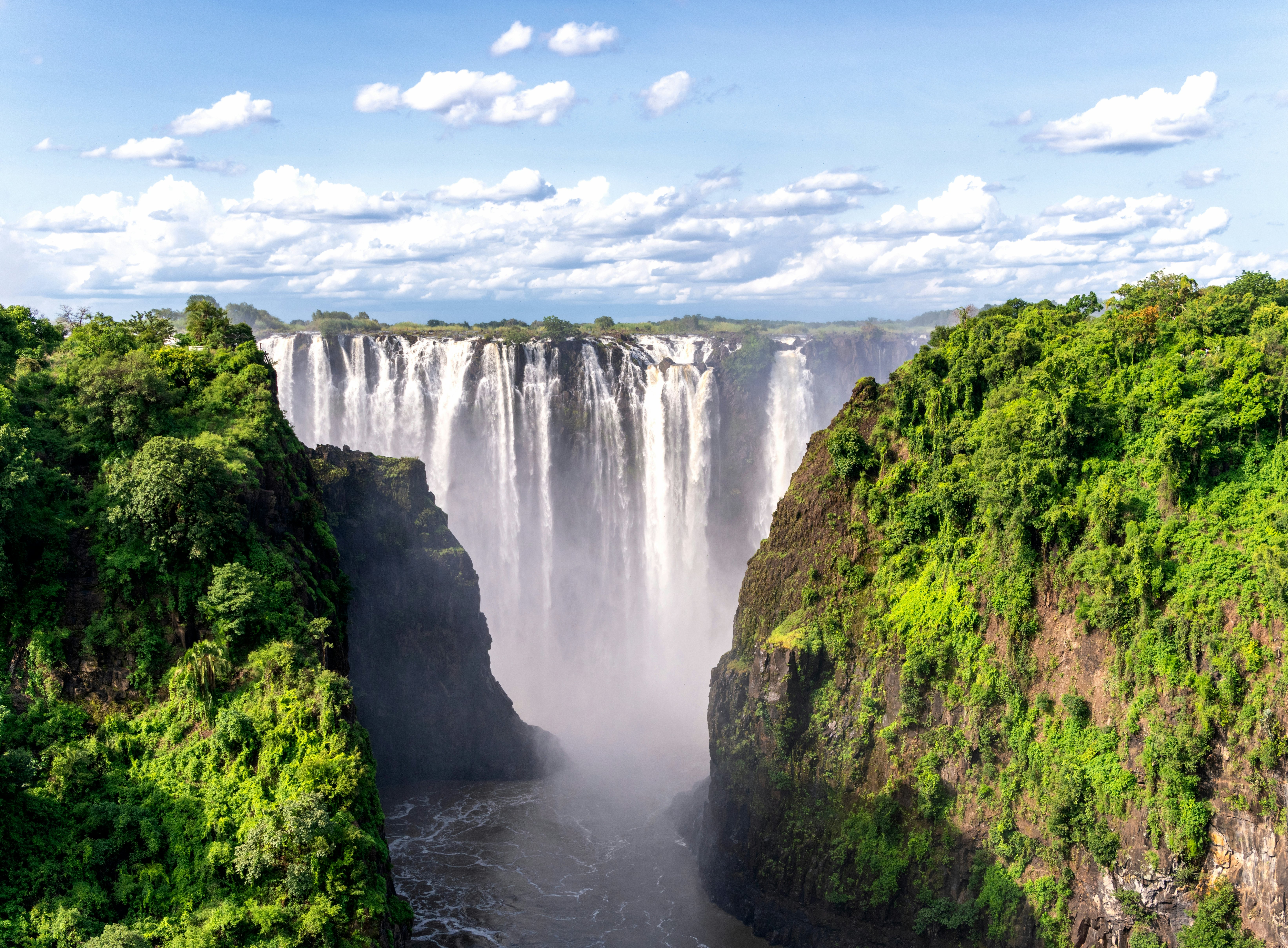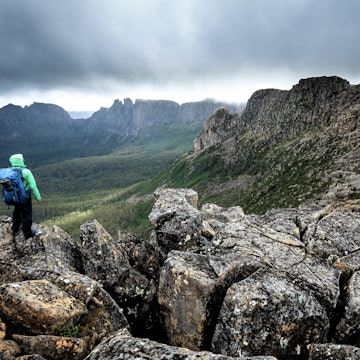

Botswana is an excellent choice for a well-rounded, first safari – though it can be a pricey one. Efimova Anna/Shutterstock
So you want to see a lion in the wild? Terrific. Now comes the tricky part: choosing where to go on your first safari.
Which countries offer the easiest introduction to the continent for first-time travelers? Which countries are best for wildlife?
Cut through the overwhelming options and plan your first safari to Africa for blockbuster wildlife watching – without feeling overwhelmed.

Planning a safari in Botswana
Why Botswana?
Water-based safaris, exclusivity, privacy and high-quality camps in captivating areas: Botswana is one of Africa’s premier wildlife-watching destinations. Its prolific wildlife inhabits extraordinary landscapes, including the Chobe River, the Okavango Delta and the salt pans of Makgadikgadi.
The easiest choice, Chobe National Park is home to the world’s largest concentration of elephants, as well as a host of easy-to-spot big cats, buffaloes, giraffes and zebras, making it perfect for first-timers. The best way to see Africa’s elephant capital is to board a boat and cruise the Chobe River’s wildlife-rich shores. From here, travel into the Okavango Delta, where you can splurge on a luxury safari and take a mokoro (dugout canoe) through the wetlands before forging on into the Makgadikgadi salt pans to mingle with meerkats.
Botswana’s appeal and ease, however, come with a (big) caveat: the cost. To avoid the pitfalls of mass tourism, most luxury lodges and camps lie in concession areas rented out by the government to enforce a high-value, low-volume, responsible tourism strategy. The best reserves sit in the swamps of the Okavango Delta, and visitors fly in on small bush planes from Maun or Kasane. Mobile safaris are group trips that take you from site to site, often involving camping along the way. They are a more cost-effective alternative and allow you to combine time in Moremi Game Reserve with Chobe National Park.
Best time to visit for a safari in Botswana
The high and dry season (June–October) is the best wildlife-watching time, and also when water levels are generally at their highest in the Okavango Delta, allowing you to glide along the channels in a mokoro.
Where to stay on safari in Botswana
In and around Chobe National Park, look to stay at Chobe Game Lodge, Chobe Safari Lodge or Chobe Bakwena, with Chobe Game Lodge being the only one inside the park. For photographers, Pangolin Chobe Hotel has specialist boats with swivel seats and gimbal mounts to snap that Attenborough moment on the Chobe River.
Combine the Chobe with the Okavango Delta through scheduled group mobile safaris with Bush Ways or Letaka. For a luxury experience in an exceptionally wild, isolated area, Mombo Camp is probably the Okavango’s most exclusive and legendary lodge, with predators galore (and a pretty price tag). Mma Dinare Camp (which offers affordable road transfers), 4 Rivers Camp, Shinde Camp and Camp Moremi are well-situated for spotting excellent big game. Xugana Island Lodge, Setari Camp and Mopiri Camp are wonderful for experiencing the waterways and offer fishing and birding opportunities by boat. Mogotlho Safari Lodge is also accessible for self-drivers and occupies a lovely position on the Khwai River near Mababe. Want a more adventurous, budget-friendly option? Try a fully catered, accommodated mokoro campout excursion that departs from Sitatunga Camp, south of Maun.
Trips to meet the cute meerkats of the Makgadikgadi salt pans can be arranged through San Camp, Jack’s Camp or Camp Kalahari, with Planet Baobab as the best budget-friendly option with self-drive access.
Budgeting and costs for a safari in Botswana
Stays at isolated camps in the Okavango Delta start at roughly US$650 per person per night and can go up to an eye-watering US$4000 a night. At approximately US$300, Chobe National Park lodges are more affordable – so stretch out your days here to keep costs down. For better pricing on accommodations, travel during the shoulder season (April–May; October-November). Finally, check the distance between your luxury lodge and Maun to reduce the return ticket cost. Some camps offer road transfers or boating access between camps to minimize travel costs.

Planning a safari in Kenya
Why Kenya?
Kenya’s wildlife offering is outstanding, with the Great Migration in particular at the top of many bucket lists – so it’s no surprise that safaris have been a thing in Kenya since the very concept was invented (indeed, safari translates to “journey” in Swahili). Do keep in mind, though, that this track record does make Kenya one of the busiest, most popular wildlife destinations on the continent.
A renowned annual phenomenon, the Great Migration sees millions of wildebeest and zebras cross the Mara River from the Serengeti in southern Tanzania into Kenya’s Masai Mara National Reserve. The country’s semi-nomadic Maasai communities and their time-honored warrior traditions are another source of fascination. Visitors can support community-powered tourism by visiting the private reserves surrounding the Mara, which are leased to different safari companies. A guided bush walk with a Maasai warrior will let you experience this culture’s deep connection with the land.
The main safari circuit couples Lake Nakuru with the Masai Mara and Amboseli (where Mt Kilimanjaro provides a staggering backdrop). Tsavo West, Tsavo East and Samburu are popular add-ons if you have extra time. Any combination of these parks should ensure ample sightings of big cats, plenty of elephants, a few rhinos and all of the plains animals, such as buffaloes, giraffes, zebras, and all manner of gazelle and antelope species. Want even more? Extend your stay by another week and scale Mt Kenya, Africa’s second-highest peak (after Kilimanjaro).
Most travelers just pass through Nairobi, staying long enough to visit Nairobi National Park. An extraordinarily well-stocked park on the cusp of one of Africa’s largest cities and easily accessible, Kenya’s original game reserve has abundant wildlife, including lions, leopards, buffaloes, endangered black rhinos, and about 400 species of birdlife.
Generally, Kenya can be a better choice for families, those on a budget and those on a tight timeline.
Best time to visit for a safari in Kenya
July to October and January to February are the best times to see the Great Migration, when a million-plus wildebeest, along with hundreds of thousands of zebras and gazelles, cross the crocodile-infested Mara River to graze on the lush grasses of the Masai Mara. With unrestricted visitor numbers, some areas can get crowded.
Where to stay on safari in Kenya
Kenya has hundreds of excellent lodges and tented camps, standards of service from local staff are generally high, and tour operators are experts at the logistics of moving between national parks for each leg of your safari itinerary.
Cottar’s 1920s Camp has entertained guests in high style for more than 100 years, while “gentle on the earth” takes on a whole new meaning at Emboo River Camp. The team there will have you floating through the grasslands of the Masai Mara in the region’s first electric game-drive vehicles.
A good value but still luxurious, Ol Tukai Lodge sits within Amboseli Park, with views of Kilimanjaro from the bar; nearby Amboseli Serena Safari Lodge is a comfortable family-friendly option. In Nairobi, Giraffe Manor provides a memorable breakfast spread before a visit to the city’s park; all accommodations in the upmarket Karen and Langata areas are close to the main entrance.
Budgeting and costs for a safari in Kenya
Masai Mara National Reserve is the most wallet-friendly location for seeing the wildebeest migration. Despite having a shorter migration season, Kenya has more flights, more tourists, stiffer competition and a greater variety of affordable accommodations than next-door Tanzania. Expect to pay anything from US$150 to US$1000 per person per night.

Meet your new travel partner
Get unlimited data while you travel with Holafly eSIM. Peace of mind and no hidden fees wherever you go. Use code LONELYPLANET for an exclusive discount.
For a cheaper safari, book between the short and long rains (January–March), when prices are usually lower than the peak season. Nairobi National Park charges US$40 to non-residents for entry, while admission to Masai Mara is US$80 for 24 hours if you stay outside the reserve and US$70 if you stay inside.

Planning a safari in Namibia
Why Namibia?
Namibia is one of the easiest Southern African countries to explore from the driver's seat. It also has dramatic desert scenery that's hard to replicate elsewhere. While a 4WD African safari is always an ambitious undertaking, Namibia has good roads, well-appointed campsites and reasonably priced rental vehicles.
The classic circuit starts in Windhoek, where you can rent a fully equipped 4WD camper van or a decent gravel-road car. From there, head to Sossusvlei in the Namib Desert for incredible vistas, circle up to Swakopmund for coastal adventures and end at Etosha National Park, where elephants, rhinos and giraffes strut their stuff.
Etosha is Namibia’s version of South Africa’s Kruger National Park, with roads and facilities suitable for a self-driving budget safari. Each public camp overlooks a busy watering hole, where game moves in and out to drink during the dry season. The camp is floodlit by night, so you won’t need to leave once you settle in.
Best time to visit for a safari in Namibia
Etosha is well-known for its productive water holes, and peak game-viewing is from June to October, when wildlife flocks to these oases dotted throughout the park. This is also a cooler time of year to climb the dramatic dunes, such as Dune 45 at Sossusvlei.
Where to stay on safari in Namibia
Arranging everything through the Gondwana Collection is hands-down the easiest and best way to organize a self-driving safari. This group has a portfolio of accommodations in all the key tourist spots, ranging from well-serviced campsites to glamping tents and swank lodges filled with character. Favorites include the quirky Desert Grace and Namib Dune Star Camp (with its alfresco beds) near Sossusvlei, and The Delight in Swakopmund. A sister company, Namibia2Go, offers car rentals with comprehensive insurance.
As an alternative, book campsites and chalets inside the parks with the government-run Namibia Wildlife Resorts. Okaukuejo Rest Camp lies inside the perimeter of Etosha and is the place to watch the watering hole.
Budgeting and costs for a safari in Namibia
At about US$800, a full week’s vehicle rental is cheaper than a single night’s stay at a luxury lodge in the Okavango Delta. Due to the vast distances between destinations in Namibia, fuel expenses can add up quickly. National parks and private campsites offer affordable camping fees, though luxury accommodations will (understandably) be more expensive. For camping, expect to pay US$20 to US$50 per person per night for camping; for lodges, US$100 to US$300.

Planning a safari in South Africa
Why South Africa?
Expect bush, beach and fine wine. From iconic Kruger National Park to the picturesque landscapes of KwaZulu-Natal, South Africa offers a safari experience that caters to all levels of adventurers.
Kruger is the easiest and most rewarding safari destination for first-timers and budget travelers. You can see the Big Five (lions, leopards, rhinos, elephants and buffaloes), as well as cheetahs, giraffes, African wild dogs and hundreds of bird species. Drive the park’s paved roads yourself if you’re on a budget. For a better shot at spotting the Big Five during a short period, book an exclusive guided experience in private reserves like Sabi Sands or Thornybush.
Lesser-known reserves in KwaZulu-Natal are equally impressive. Hluhluwe-iMfolozi is just as accessible as Kruger from the city of Durban and has excellent facilities for travelers on all budgets; expect to spot rhinos, elephants, buffaloes, zebras, giraffes and wildebeest. (The big cats are a little more challenging to see here.) Nearby Phinda Private Game Reserve offers stunning high-end stays – plus the possibility of a beach day or scuba diving at Sodwana Bay.
Madikwe Game Reserve in North West Province is close to the Botswana border and a four-hour drive from Johannesburg, making it popular for South Africans looking for a safari. It’s also a malaria-free option for families with young children.
Combine any of these safari parks with a flight south to Cape Town, and you’ll add fine wine, world-class restaurants and a seaside safari – visiting the African penguins of Boulders Beach – to your itinerary.
Best time to visit for a safari in South Africa
While South Africa is a year-round destination, most visitors love the cooler, dry season between May and August. During these months, wildlife is easier to spot as vegetation is more sparse and animals gather around watering holes.
Where to stay on safari in South Africa
There are plenty of affordable self-catering rest camps in Kruger National Park and Hluhluwe-iMfolozi run by SANParks, the government parks agency. Kruger’s southern zone is prime game-viewing territory, with Skukuza, Lower Sabie and Letaba rest camps all favorites. Hilltop Camp in Hluhluwe-iMfolozi has terrific views, while Rhino Ridge Safari Lodge is a superb, privately run option that supports the local community.
Plush camps and lodges in the private reserves come with highly trained guides who can take you out on foot or by vehicle. You can’t go wrong at Saseka in Thornybush, Dulini in Sabi Sands, Tanda Tula in Timbavati, Jaci’s Safari Lodge in Madikwe or any of the &Beyond accommodations in Phinda.
Budgeting and costs for a safari in South Africa
Rates range from US$100 to US$200 per person per night in government-run camps. Mid-range prices start at US$300 to US$700 per person per night, with a corresponding bump in accommodation and guiding quality.

Planning a safari in Tanzania
Why Tanzania?
Limitless plains, the epic migration and relaxing dips in the Indian Ocean. Tanzania’s northern safari circuit includes the amazing Serengeti National Park and Ngorongoro Crater. Exploring these places for 10 days to two weeks is a sure way to fall in love with Africa. Consider adding a few days on the island of Zanzibar (officially called Unguja) to make your dream trip even more memorable.
Tanzania and Kenya share similarities, both having plentiful wildlife parks and excellent safari operators. Tanzania’s vibe, though, is generally less stressful – perhaps due to the fact that the Serengeti is nearly 10 times bigger than Kenya’s Masai Mara, offering endless horizons and greater habitat variety.
In the heart of the Serengeti, the Seronera River provides big cat and herbivore sightings year round, making it popular with visitors. Kogatende and Lamai, on the Mara River, are ideal for observing river crossings – with fewer tourists. Private reserves such as Grumeti allow viewings of the migration without the crowds (and for a price).
The Ngorongoro Crater is only a short drive to the east from the Serengeti. In this giant collapsed volcano (or caldera), animals like lions, elephants and black rhinos are enclosed as they prowl a complete ecosystem of pretty plains and dramatic forests. Note that because of this, in peak season, crowds are inevitable.
Best time to visit for a safari in Tanzania
Plan a visit between January and March to witness the migration of wildebeest – and their newborns – passing through the Ngorongoro and Ndutu regions. (Get as early a start as possible to avoid day-trippers.) The best time to witness the famous wildebeest river crossings in the Serengeti is during the peak season (July–August).
Where to stay on safari in Tanzania
Serengeti Serena Safari Lodge is an upmarket accommodation inspired by traditional Tanzanian architecture; its popular mobile safari offering is Kiota Camp. Run entirely by women, Dunia Camp is a luxury tented property situated in prime lion territory. Ngorongoro Serena Safari Lodge is a great value, permanent lodge conveniently located near the entrance to the Ngorongoro Crater. For an even more budget-friendly option, consider Bougainvillea Safari Lodge. For a different kind of stay, book Gibb’s Farm, which is situated on a working coffee farm and offers campfire storytelling and other fun extras.
On the coast, Chumbe Island in Zanzibar/Unguja is a highly rated, eco-friendly property that offers sensational snorkeling in a protected marine reserve. In the historic heart of Stone Town, the best value is at stay at Zanzibar Coffee House, dating from the 19th century.
Budgeting and costs for a safari in Tanzania
Expect to pay anything from US$250 to US$950 per room per night during your stay in Tanzania. Entry fees at Serengeti National Park for foreign tourists are US$70 (peak season) and US$60 (low season). To visit the Ngorongoro Crater, you’ll pay US$250 for a vehicle in addition to the same entry fee. These fees are typically included in organized safari packages.

Planning a safari in Zambia
Why Zambia?
Track rhinos, witness an awe-inspiring cascade and join a walking safari to experience nature up close. Indeed, Zambia is celebrated worldwide as the birthplace of the safari on foot. Under the guidance of two armed rangers, rhino tracking in nearby Mosi-oa-Tunya National Park will bring you close to these magnificent animals – a taste of what’s to come at South Luangwa.
Livingstone, the tourist capital of Zambia, lets you gaze at another (non-living) marvel: mighty Mosi-oa-Tunya, better known as Victoria Falls. If the 935 cu meters (33,000 cu ft) of water that pours over the falls each second is not heart-pumping enough, there are plenty of other thrilling activities to enjoy, such as white-water rafting on the Zambezi River and bungee jumping (also available on the Zimbabwe side of Victoria Falls). During July and August, you can even take a refreshing dip in the natural infinity pool at the edge of the falls.
Several small and rustic camps in the Luangwa Valley cater just to walking safaris – a thrilling alternative to traditional game drives. These camps are mainly located in South Luangwa National Park.
Best time to visit for a safari in Zambia
Peak game viewing is from June to October, and Victoria Falls is at its best on the Zambia side from March to May.
Where to stay on safari in Zambia
Flatdogs Camp in South Luangwa National Park offers family-friendly luxury. In Livingstone, Jollyboys Backpackers provides a vibey base from which to explore town. The Victoria Falls Waterfront provides a free shuttle to the main event – but if you want to stay at the falls with unlimited access, the swish Royal Livingstone Resort is top-notch; the three-star Avani Victoria Falls Resort is next door.
Green Safaris operates a great circuit of camps in Zambia if you want to combine Victoria Falls with South Luangwa. Live the Robinson Crusoe life at Sindabezi Island Lodge on the Zambezi, and then head into the bush at Shawa Luangwa Camp. You can’t go wrong with walking-safari operators Time + Tide (its camp Kakuli is a classic that’s been open since 1950) or Robin Pope.
Budgeting and costs for a safari in Zambia
Consider getting the KAZA UniVisa, a special US$50 pass for unlimited crossings within 30 days between Zambia and Zimbabwe, plus a one-day trip to Botswana (via the Kazungula border crossing). Budget US$250 to US$700 per person per night for lodging.

Planning a safari in Zimbabwe
Why Zimbabwe?
The adventurous choice for a first-time safari, Zimbabwe has arguably the best guides in Africa. The easiest way to experience it all? Spend three days in Victoria Falls. Since it’s one of the country’s most popular tourist towns, you’ll find plenty to see, do and eat.
The meandering rainforest walkway in Zimbabwe is where the majority of Victoria Falls viewpoints lie. This is a better option for experiencing the falls during during the dry season (May–October), when water levels on the Zambian side lessen. On some evenings and during the full moon, Victoria Falls National Park in Zimbabwe remains open at night for dazzling stargazing.
After a day of adrenaline-fueled bungee jumping, white-water rafting, zip-lining or hovering in a helicopter above Batoka Gorge, afternoon tea at the Victoria Falls Hotel, served every day between 3pm and 6pm, offers some refined relaxation as you share a tiered stand of pretty sandwiches and delicate pastries beside the manicured lawns. If this is beyond your budget, enjoy a simple gin-and-tonic sundowner – or head to the Wild Horizons Lookout Café.
The wildlife around here is less prolific than nearby Chobe National Park in Botswana (which you can visit on a day trip or easily combine with Victoria Falls). You might spot hippos, crocodiles or the occasional elephant on a boat cruise, and to find bigger game, hop a 45-minute flight or drive two hours to Hwange National Park.
Best time to visit for a safari in Zimbabwe
There is fantastic wildlife viewing during the dry months, from May to October. Victoria Falls is at its peak from March to May.
Where to stay on safari in Zimbabwe
Victoria Falls Safari Lodge sits on a ridge and overlooks a watering hole frequented by buffaloes and other beasts. Nkosi Guest Lodge is a pretty, upmarket inn, while Ilala Lodge Hotel is just a 10-minute walk from Victoria Falls. The Victoria Falls Hotel, the iconic grande dame, offers perhaps the best views. Further afield, ensconce yourself in the bush at Mpala Jena, about 40km (25 miles) upstream. In Hwange, The Hide, Camp Hwange and Somalisa are all visitor favorites.
Budgeting and costs for a safari in Zimbabwe
Entry to Victoria Falls is US$50. With the wide range of accommodation options, you can spend US$150 to US$700 per person per night.














